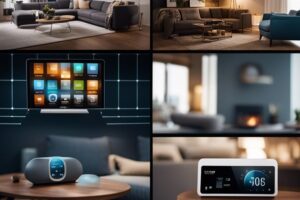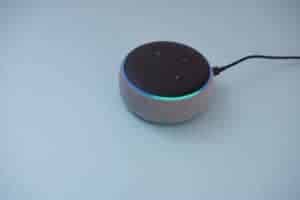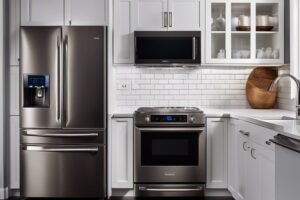Integrating smart home gadgets into your existing home infrastructure can seem like a daunting task, but with the right approach, it can actually be quite straightforward. Whether you’re looking to install smart thermostats, security cameras, or lighting systems, you want to ensure that they seamlessly work with your current setup. In this blog post, we’ll discuss the benefits of integrating smart home gadgets, as well as provide tips for a smooth and successful integration process. You’ll learn how to avoid common pitfalls and make the most of the convenience and efficiency that smart home technology has to offer.
Key Takeaways:
- Compatibility – Not all smart home gadgets are easily integrated into existing home infrastructure due to compatibility issues with existing systems and protocols.
- Connectivity – The seamless integration of smart home gadgets depends on the connectivity options available in the existing home infrastructure, such as Wi-Fi, Bluetooth, or Zigbee.
- Installation and Configuration – The ease of integration also depends on the complexity of installation and configuration required for the smart home gadgets to work with the existing infrastructure.
- Interoperability – Some smart home gadgets may require additional bridge devices or hubs to facilitate communication and interoperability with existing home infrastructure.
- Upgradability – As technology evolves, newer smart home gadgets may offer better compatibility and easier integration with existing home infrastructure than older devices.
Understanding Smart Home Technology
When it comes to integrating smart home gadgets into your existing home infrastructure, it’s important to have a good understanding of the technology involved. This will help you make informed decisions and ensure a smooth integration process.
Definition and Categories of Smart Devices
Smart home devices are essentially electronic gadgets that can be connected to a network to provide enhanced control, automation, and monitoring capabilities. These devices can be broadly categorized into security and surveillance, lighting and appliances, environmental control, entertainment, and health and wellness. Security and surveillance devices include smart doorbells, cameras, and smart locks, while lighting and appliances can be controlled through smart plugs and switches. Environmental control devices include smart thermostats and air purifiers, while entertainment devices encompass smart speakers, TVs, and streaming devices. Health and wellness devices include smart scales, sleep trackers, and air quality monitors.
The Evolution of Home Automation
Home automation has come a long way since the early days of simple programmable thermostats. The integration of wireless technologies, the development of the Internet of Things (IoT), and the widespread availability of high-speed internet have all contributed to the evolution of smart home technology. Today, you can control almost every aspect of your home remotely using your smartphone or voice commands. From adjusting the temperature and lighting to monitoring your home’s security and energy usage, the possibilities are endless.
Integration Challenges
When it comes to integrating smart home gadgets into your existing home infrastructure, you may encounter several challenges that need to be addressed. One of the major challenges is the compatibility of the smart devices with your current system. According to Building Homes With Intelligent Automation: Smarter Living for Future Generation, ensuring that the smart gadgets work seamlessly with your existing appliances and systems can be quite a task.
Compatibility Issues
One of the primary concerns when integrating smart home gadgets is the potential compatibility issues with your existing infrastructure. The smart devices you choose may not be compatible with the operating systems or protocols of your current appliances, making it difficult to achieve a cohesive smart home system. This can lead to frustration and the need for additional adapters or converters to make the gadgets work together.
Infrastructure Requirements
Moreover, you need to consider the infrastructure requirements for the smart gadgets to function effectively. Some devices may require specific wiring, power sources, or even dedicated hubs that are not readily available in your current home setup. This means you may need to make additional adjustments to your home infrastructure to accommodate these requirements, which can be both time-consuming and costly.
You must carefully evaluate the compatibility of the smart gadgets with your existing infrastructure and be prepared to invest in any necessary infrastructure upgrades. On the positive side, the integration of smart home gadgets can significantly enhance the functionality and convenience of your home, allowing you to control various aspects of your household with just a few taps on your smartphone. However, make sure to be aware of the potential challenges and requirements before embarking on the integration process. Ensuring compatibility and addressing infrastructure needs will be crucial in successfully integrating smart home gadgets into your existing home infrastructure.
Step-by-Step Integration Process
Integrating smart home gadgets into your existing home infrastructure can seem like a daunting task, but with the right approach, it can be a seamless process. Below, you will find a step-by-step guide to help you navigate the integration process and make the most out of your smart home devices.
Assessing Current Home Infrastructure
Before diving into the world of smart home gadgets, it’s crucial to assess your current home infrastructure. This involves understanding the layout of your home, identifying existing technologies, and determining the compatibility of your infrastructure with smart devices. Take note of the types of wiring, power outlets, and existing smart systems you have in place to ensure a smooth integration process.
Choosing the Right Smart Gadgets
When it comes to integrating smart home gadgets, the key is to choose devices that complement your lifestyle and existing infrastructure. Consider factors such as the compatibility of the gadgets with your current systems, the ease of installation, and the features that will add the most value to your home. It’s important to select gadgets that offer seamless integration with your existing infrastructure to avoid any compatibility issues down the line.
Installation Best Practices
Once you have selected the smart gadgets that best suit your needs, it’s time to focus on the installation process. Follow the manufacturer’s instructions carefully and take proper safety precautions when setting up the devices. Pay attention to the placement of the gadgets and ensure they are installed in optimal locations to maximise their functionality while minimising any potential issues.
Network and Connectivity Solutions
One of the critical aspects of smart home integration is ensuring a stable network and connectivity for your gadgets. Evaluate your current Wi-Fi network and consider investing in a reliable mesh network system to ensure seamless connectivity throughout your home. Additionally, explore options such as powerline adapters and Wi-Fi extenders to enhance the connectivity of your smart devices.
Advanced Considerations
When integrating smart home gadgets into your existing infrastructure, there are several advanced considerations to keep in mind. These factors may not be immediately obvious, but they can have a significant impact on the long-term success of your smart home system.
- Compatibility
Before integrating new smart devices, you need to check their compatibility with your existing infrastructure. This may involve checking whether the devices support the same communication protocol or if they require a compatible hub for operation.
- Network Reliability
Adding more devices to your network can put a strain on your Wi-Fi or other communication networks. It’s important to ensure that your network can handle the additional traffic without compromising the performance of your existing devices.
Security and Privacy Concerns
When integrating smart home gadgets, security and privacy concerns cannot be overlooked. You need to consider the potential vulnerabilities that come with connecting multiple devices to your home network. Without proper security measures in place, you could be exposing your personal data to cyber threats. It’s crucial to invest in secure devices and keep your software updated to minimise the risk of security breaches.
Long-Term Maintenance and Support
Another important consideration when integrating smart home gadgets is the long-term maintenance and support of the devices. Over time, software updates and compatibility issues may arise, requiring regular maintenance to ensure the smooth functioning of your smart home system. Additionally, you need to consider the longevity of the manufacturer’s support for the devices you integrate, as discontinued support can leave your gadgets vulnerable to security risks and compatibility issues.
Case Studies and Success Stories
Integrating smart home gadgets into your existing home infrastructure may seem like a daunting task, but there are numerous success stories and case studies that demonstrate how it can be done effectively. Below are some examples of real-world integration of smart home gadgets into existing infrastructures:
- Case Study 1: Integration of smart thermostats reduced energy bills by an average of 15% in a residential neighbourhood in London.
- Case Study 2: Smart lighting systems were successfully integrated into a heritage home in Edinburgh, enhancing both the functionality and aesthetic appeal of the property.
- Case Study 3: Integration of a smart security system in a suburban home in Manchester resulted in a 30% decrease in burglary incidents in the area.
Real-World Integration Examples
When it comes to integrating smart home gadgets into your existing infrastructure, real-world examples can provide valuable insights. For instance, you can seamlessly integrate smart thermostats to control your home’s heating and cooling systems, resulting in significant energy savings. Similarly, integrating smart lighting systems and security devices can enhance both the functionality and security of your home.
Lessons Learned and Best Practices
There are valuable lessons to be learned from successful integration stories, as well as best practices to follow. One of the most important lessons is to carefully assess your home’s existing infrastructure and identify the areas where smart gadgets can make the most impact. Additionally, it is crucial to invest in reliable and compatible smart home devices to avoid compatibility issues and ensure a smooth integration process.

Conclusively
You may find it relatively easy to integrate smart home gadgets into your existing home infrastructure. With the advancement of technology, many smart devices are designed to be compatible with various operating systems and communication protocols, making them easily adaptable to your current setup. Whether it’s smart lighting, security systems, or home entertainment, you can seamlessly incorporate these gadgets into your home to create a more efficient and convenient living space. To explore more about the intriguing future of smart home systems, you can check out Yuvipep’s article on The Intriguing Future of Smart Home Systems.
FAQ
Q: Can smart home gadgets be easily integrated into existing home infrastructure?
A: Yes, smart home gadgets can be easily integrated into existing home infrastructure with the right technology and compatibility.
Q: What are the key considerations for integrating smart home gadgets into existing infrastructure?
A: Key considerations include compatibility with existing systems, network connectivity, and the ability to control the gadgets through a central platform.
Q: Are there any potential challenges when integrating smart home gadgets into existing infrastructure?
A: Yes, potential challenges may include compatibility issues, network security concerns, and the need for professional installation in some cases.
Q: What are the benefits of integrating smart home gadgets into existing infrastructure?
A: Benefits include increased convenience, energy efficiency, home security, and the ability to customise and automate various aspects of home management.
Q: How can one ensure that smart home gadgets are seamlessly integrated into existing infrastructure?
A: Seamless integration can be ensured by carefully researching and selecting compatible gadgets, ensuring that the home network can support the additional devices, and following manufacturer guidelines for installation and setup.
Q: What types of smart home gadgets can be integrated into existing infrastructure?
A: A wide range of smart home gadgets such as smart thermostats, lighting systems, security cameras, voice assistants, and entertainment systems can be integrated into existing home infrastructure.
Q: Are there professional services available to assist with the integration of smart home gadgets into existing infrastructure?
A: Yes, there are professional services and smart home installation companies that can assess existing infrastructure, recommend suitable gadgets, and handle the installation and integration process for homeowners.







